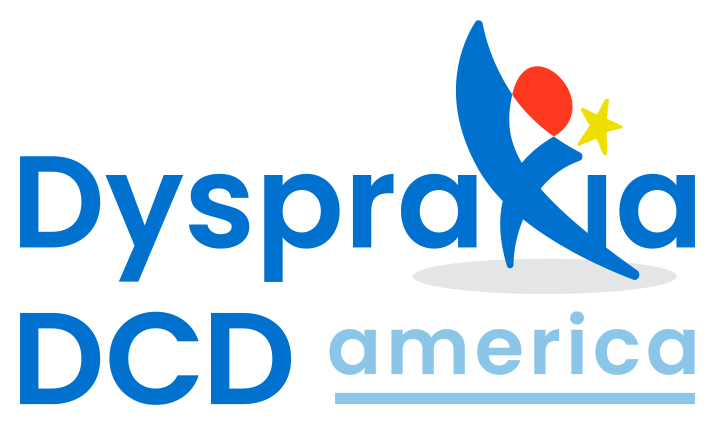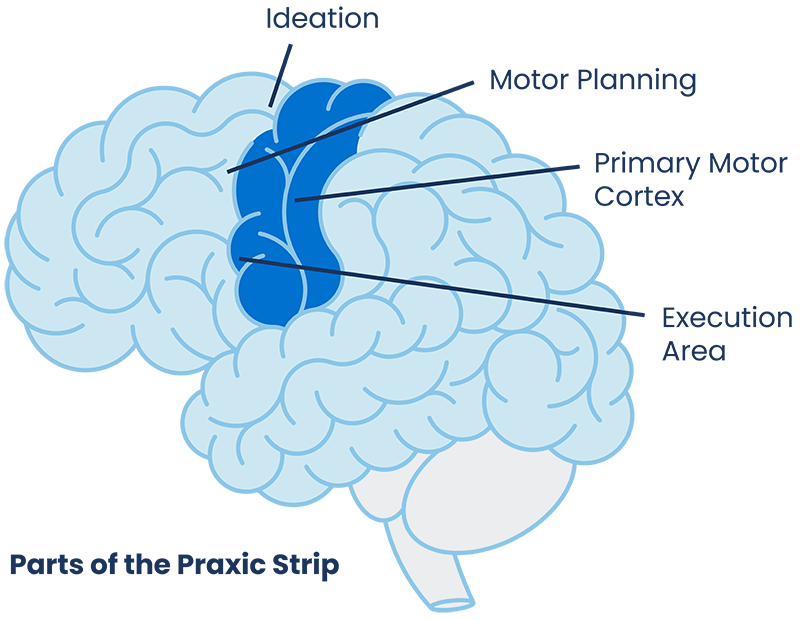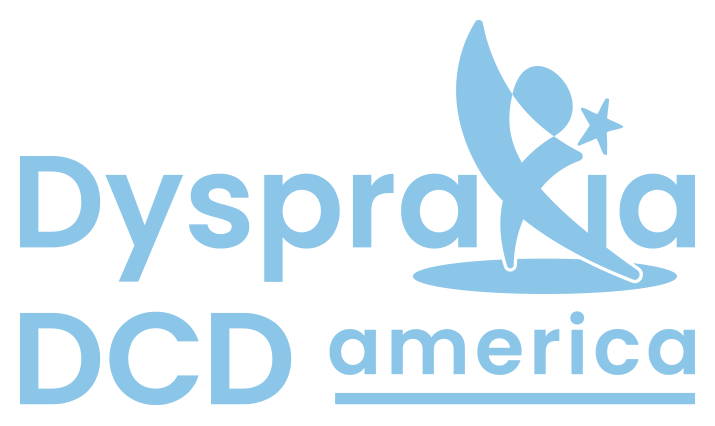Developmental Coordination Disorder (DCD), commonly known as Dyspraxia, is a neurodevelopmental condition that affects fine and/or gross motor skills, including motor planning and execution.
Dyspraxia/DCD does not affect intelligence, but it can affect the ability to keep up in school and make learning more challenging compared to peers. Difficulty making friends, depression and anxiety may result from the frustration, embarrassment, and stigma of struggling to keep up with peers.

Dyspraxia/DCD is a chronic, hidden lifelong condition that affects each person differently.
Dyspraxia/DCD Signs & Symptoms
Difficulties with movement, coordination, and motor planning are the main signs and symptoms of Dyspraxia/DCD, but struggles in other areas may also occur. Symptoms vary widely from one individual to another, and for the same individual from one day to the next.
How Common is Dyspraxia/DCD?
Dyspraxia/DCD affects 5 to 6% of the population (Blank et al., 2019).
This means that more than 1 in 20 Americans are affected and it impacts almost 20 million people in the United States. Every classroom is likely to have at least one student coping with Dyspraxia/DCD.
Despite being almost as common as ADHD and more common than Autism, it is unfamiliar to many parents, teachers, and healthcare professionals in the United States.
Why Haven’t I Heard of It?
Although Dyspraxia/DCD is under-recognized throughout the world, the United States is significantly behind other countries.
Dyspraxia/DCD is well-known in the United Kingdom thanks to the Dyspraxia Foundation that was established in 1987.
In academic research, the United States ranked 4th after Canada, England, and Australia in a literature review of publishing trends in DCD research (Wu et al., 2021).
Given that the US population is greater than the other top countries combined, this is a disappointing statistic. DCD Dyspraxia America plans to support academic research in the United States!
Having different terms to refer to the same condition (Dyspraxia or DCD) makes spreading awareness very challenging.
Why Haven’t I Heard of It?
Although Dyspraxia/DCD is under-recognized throughout the world, the United States is significantly behind other countries.
Dyspraxia/DCD is well-known in the United Kingdom thanks to the Dyspraxia Foundation that was established in 1987.
In academic research, the United States ranked 4th after Canada, England, and Australia in a literature review of publishing trends in DCD research (Wu et al., 2021).
Given that the US population is greater than the other top countries combined, this is a disappointing statistic. DCD Dyspraxia America plans to support academic research in the United States!
Having different terms to refer to the same condition (Dyspraxia or DCD) makes spreading awareness very challenging.
“Unfortunately, DCD isn’t well understood in any country. But, in a place like the US… the lack of acknowledgment feels astonishing.”
Hollander J, Marie Claire Magazine, 2021
Dyspraxia or DCD?
There are different perspectives and opinions about the definitions of Dyspraxia and Developmental Coordination Disorder (DCD). DCD is the only formal term, but many people prefer to use Dyspraxia instead.
Some believe they are one and the same, while others believe they are different. Dyspraxia DCD America uses the terms together to refer to the same condition. One of Dyspraxia/DCD America’s most important missions is to increase awareness, and we believe that consistency in terminology can support that.


DCD is the Official Term for Diagnosis and Academic Research
DCD is the formal term healthcare professionals use because it is listed in the Diagnostic and Statistical Manual (DSM-5) as code 315.4. Developmental Dyspraxia is in the International Classification of Diseases (ICD-11), but in the US we mainly use the DSM-5 for a diagnosis. Most formal research also uses DCD.
Although the term “developmental” is often associated with childhood milestones, it actually refers to growth and change throughout the lifespan including childhood, adulthood, and old age. Thus, DCD begins in childhood and continues to affect individuals at every age and stage of life.
DCD may be the best term to use for medical insurance purposes as well as for conversations with school when advocating for your child or yourself.
Dyspraxia is Often Used in the Community and in the Media
Many people prefer the term Dyspraxia because it is simpler and shorter. It defines movement that is slower, less coordinated, or less accurate.
In the United Kingdom (UK), where there is more awareness than in the US, the term Dyspraxia is more common. The Dyspraxia Foundation of the UK also uses Dyspraxia to mean the same thing as the official definition of DCD.
Reviewed by Priscila Tamplain, Ph.D., Director of the Motor Development Lab in Arlington, Texas.
References
American Psychiatric Association. (2013). Diagnostic and statistical manual of mental disorders (5th ed.). Washington, DC.
Blank R, Barnett AL, Cairney J, Green D, Kirby A, Polatajko H, et al. (2019). International clinical practice recommendations on the definition, diagnosis, assessment, intervention, and psychosocial aspects of developmental coordination disorder. Dev Med Child Neurol., 61:242–85
Danielson, M. L., Bitsko, R. H., Ghandour, R. M., Holbrook, J. R., Kogan, M. D., & Blumberg, S. J. (2018). Prevalence of Parent-Reported ADHD Diagnosis and Associated Treatment Among U.S. Children and Adolescents, 2016. Journal of clinical child and adolescent psychology : the official journal for the Society of Clinical Child and Adolescent Psychology, American Psychological Association, Division 53, 47(2), 199–212
Hollander, J. (2022, July 27). Millions of Americans Have My Disability, You’ve Probably Never Heard of It. Marie Claire. https://www.marieclaire.com/health-fitness/a35292137/dyspraxia-developmental-coordination-disorder-in-america
Tal-Saban M, Zarka S, Grotto I, Ornoy A, Parush S. (2012, Nov-Dec). The functional profile of young adults with suspected Developmental Coordination Disorder (DCD). Res Dev Disabil. 33(6):2193-202.
Thomas, R., Sanders, S., Doust, J., Beller, E., & Glasziou, P. (2015). Prevalence of attention-deficit/hyperactivity disorder: a systematic review and meta-analysis. Pediatrics, 135(4), e994–e1001.
The World Bank, Data (2021). Population, Total: All Countries and Economies [Data file]. Retrieved from https://data.worldbank.org/indicator/SP.POP.TOTL.
Wu M-Q, Wu D-Q, Hu C-P and Iao L-S (2021). Studies on Children with Developmental Coordination Disorder in the Past 20 Years: A Bibliometric Analysis via CiteSpace. Front. Psychiatry, 12:776883.
Zeidan J, Fombonne E, Scorah J, Ibrahim A, Durkin MS, Saxena S, Yusuf A, Shih A, Elsabbagh M. (2022). Global prevalence of autism: A systematic review update. Autism Res., 15(5):778-790.
Zwicker JG, Suto M, Harris SR, Vlasakova N, Missiuna C. (2018). Developmental coordination disorder is more than a motor problem: Children describe the impact of daily struggles on their quality of life. British Journal of Occupational Therapy.;81(2):65-73.



